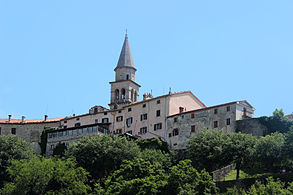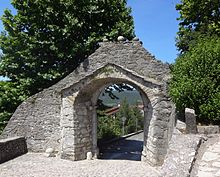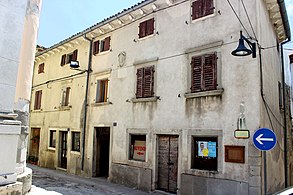Buzet (Croatia)
|
Buzet pinguente |
|||
|
|||
|
|
|||
| Basic data | |||
|---|---|---|---|
| State : |
|
||
| County : |
|
||
| Height : | 151 m. i. J. | ||
| Residents : | 6,133 (2011) | ||
| Telephone code : | (+385) 052 | ||
| Postal code : | 52 420 | ||
| License plate : | PU | ||
| Structure and administration (status: 2013, cf. ) |
|||
| Community type : | city | ||
| Mayor : | Siniša Žulić ( IDS / DDI ) | ||
| Postal address : | Ul. II. Istarske brigade 11 52 420 Buzet |
||
| Website : | |||
Buzet (Italian Pinguente ) is a town in Istria County , Croatia . Buzet is located on the Mirna and Bračana rivers . The municipality of Buzet / Pinguente has a good 6100 inhabitants, of which almost 1700 live in the city center. The municipality of Buzet / Pinguente also includes Hum , which is considered the smallest town in the world.
Districts
The municipality of Buzet consists of the following districts (Italian name and population in brackets according to the 2011 census):
|
|
population
According to the 2011 census, the municipality of Buzet had 6133 inhabitants, of whom 3,049 were male and 3,084 were female.
According to ethnicity, 75.7% of the inhabitants of the municipality were Croatians , 3.6% Bosniaks , 1.0% Slovenes , 0.8% Serbs , 0.7% Italians , 0.3% Macedonians , 0.2% Albanians and 0 , 4% stated another recognized ethnic group. 15.8% of the inhabitants called themselves Istrians or stated another regional affiliation. For the remaining 1.5%, the ethnicity was not given or was unknown. By citizenship, around 99.0% were Croatians (of which 3.7% had dual citizenship) and 0.9% were foreigners.
96.8% used Serbo-Croatian as their mother tongue , with 95.1% describing the language as Croatian , 1.4% as Bosnian and 0.2% as Serbian . 1.1% said Italian as their mother tongue, 1.1% Slovenian , 0.3% Albanian , 0.2% Macedonian and 0.5% said another language. The mother tongue of the remaining 0.2% of the population was unknown. The official language of the municipality is Croatian.
According to religion, 83.7% of the population were Catholics , 3.9% Muslims , 0.8% Orthodox and 0.3% indicated a different religious affiliation. 7.6% were non-denominational , in the remaining 3.7% the religion was not given or was unknown.
history
The first settlement on the rock arose in the Bronze Age. The Romans built the settlement of Pinguentum at this strategically important location . The name is passed down through a Roman votive tablet from the 1st or 2nd century. After the fall of the Western Roman Empire in 476, the city came under the rule of the Byzantine Empire or under the influence of the Lombards . In Pinguente ruled from the 9th to the 11th century, the Franks , later ruled Carolingian Margrave the city, which in turn the city the Patriarch of Aquileia gave.
At the beginning of the 15th century (1412), Pinguente was taken by Venice , whose influence lasted until the fall of the Lion Republic in 1779. Many of the palaces and buildings that still exist today, as well as the fortification wall, were built during this period. Despite the protective power of Venice, the city and its surroundings suffered both from the attacks and looting by the Ottomans and from the devastating effects of the Uskok War .
At the Congress of Vienna in 1815, Pinguente was placed under Austrian rule when the Illyria region was assigned to the Habsburgs . After the First World War and the end of the Austro-Hungarian monarchy, Buzet fell to Italy in the Treaty of Saint-Germain in 1919 . Towards the end of World War II, after Italy's surrender, the city fell to Nazi Germany from 1943 to 1945. After the end of the war, the city and region were incorporated into the Socialist Federal Republic of Yugoslavia .
Attractions
The historical town is characterized by the many palatial patrician houses built by the Venetian military administration from the middle of the 16th to the middle of the 18th century. From the former by the Venetians in the 15./16. The city wall, built in the 19th century, still features the two city gates, the Great Gate (Vela Vrata) from 1547 (there is a relief of St. George, the patron saint of the fortress) and the Small Gate (Mala Vrata) from 1592 as well as the Südwal, which was built during the 16th century and renovated in 1699 .
The cistern , built in 1789 in the Rococo style, stands on the main square . The fountain is adorned with the coat of arms of Antonio Trevisan, the captain of the city at the time, and the relief of a winged lion of St. Mark.
The baroque parish church of the Blessed Virgin Mary (Župna crkva Blažene Djevice Marije) dates from 1784, built on the site of an older church. The organ by the organ builder Gaetano Callido was installed in 1787. To the west of the church stands the bell tower built in 1897 . The year 1541 is engraved in Glagolitic script on the bell taken from the previous building .
The Church of St. George (San Giorgio or Sv. Jurja) north of the city was completed in 1611 and expanded during the 18th century. The interior of the church is furnished with a gilded wooden altar and choir stalls carved in the 17th century. Also worth seeing is the painting “Miracle of St. Anthony of Padua” from the school of Giovanni Domenico Tiepolo .
The local museum (Zavičajni muzej) is located in the Bigatto Palace, built in 1639, next to the city gate Porta Piccola . It shows archaeological remains from the Bronze and Iron Ages, from antiquity and the early Middle Ages and historical evidence up to the time of fascism. The museum's collections also include tools, household items and traditional costumes from Buzet and its surroundings. In a wall on the square in front of the museum there is still a complaint mailbox (cf. Bocca di Leone ) for the denunciation from the Venetian period, although it does not have the snapdragon as a design element around the slot.
The medieval chapel of St. Vitus is located below the old town fortress next to the cemetery . The chapel is decorated with reliefs of St. Vitus , Roman capitals and the coat of arms of the former city administrator (Capetani) Marc'Antonio Erizzo. The bell tower was built later in the 16th century (has inscriptions from 1614 and 1653).
traffic
Buzet has a station of the same name on the Divača – Pula line .
Motorsport
As part of the European Mountain Championship , a run will be held near Buzet. The route length is 5001 m.
Web links
- Buzet Official website of the city of Buzet (Croatian)
- Istra - Official tourist portal of Istria Description Buzet (English version)
- Official portal of the Buzet Tourist Board (German version)
- Istrian from Smrikve Description Buzet (English)
- Local history museum Buzet official website (Croatian)
- Buzetski Dani website for the FIA European Hill Climb Championship race

















